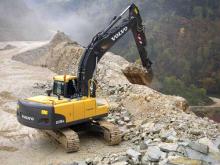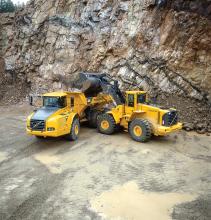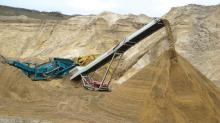
Choice of primary loading equipment depends on the quarry layout as well as geographical preferences. Claire Symes looks at the options
When it comes to loading at the quarry face, operators have a choice of wheeled loaders or excavators but it is not a simple choice.
Legislation is some regions of Europe dictate the options but in other areas it is the quarry layout and cost implications that are the deciding factor.
"The choice between wheeled loaders and excavators comes down to capital cost or cost per tonne of operation," said
"Extraction from banked or blasted material can be handled by both types of machine, although if there's a need for a mix of products at different locations in the quarry then the wheeled loader comes into its own," he said.
"Similarly, if the quarry is arranged such that the bench heights suit a backhoe type operation then excavators provide the most economical solution."
MARKET DEMAND
"One of the main factors influencing the choice of excavators to wheeled loader is the distance to transport," said Smith. "Loaders are more flexible allowing to load and transport but excavators can only load. Overall the operating cost of wheeled loaders is lower." Deleu added, "I think geographic location and quarry layout both influence an operator's choice in selecting an excavator or a wheeled loader as the most effective prime mover. I also believe that personal preference plays a significant role in that choice.
"Generally speaking the choice is also affected by the design of the quarry and the blasting solution. In some cases, an excavator working from above is the safest and most productive solution to moving material. In others, wheeled loaders working from below are highly mobile and offer the benefit of being able to work across multiple areas of the quarry with little delay." Migeotte added, "I would always put a large loader in as a first choice as they are better for production and can outperform an excavator but underfoot conditions, bench height and restricted space may change this.
"Wheeled loaders are better suited to applications where material blending is required - such as in cement quarries - but excavators can be used with drop balls. The higher breakout force of excavators may also be essential where the blast cannot achieve full fragmentation.
However, a quarry carrying out smaller, more frequent blasts will save time with the greater mobility of a wheeled loader compared to that of an excavator." Volvo sales engineer for wheeled loaders in Europe Gunnar Lövestrand said, "The benefit of a wheeled loader in a quarry, when compared to an excavator, is mobility and versatility.
"In most quarries the face is wide and extracting material demands a mobile operation, which inherently means a wheeled loader. Furthermore, when it comes to crushing, wheeled loaders are synonymous with feeding blasted rocks in to crushers and handling the aggregate afterwards. The demand in the latter case calls for speed, productivity and flexibility and here wheeled loaders can offer good productivity and efficiency in terms of tonnes per hour and litres of fuel per tonne."
REGIONAL VARIATION
"In Germany and Eastern Europe there is a strong preference for front shovel excavators where as you will never see one in France, Spain or the UK," explained Migeotte. "Safety is also a decision factor - in the UK, the need to be able to reach the top of the bench for cleaning drives the decision towards excavators." What is clear is that there is no one size fits all solution when it comes to face loading and all aspects of the quarry's operation need to be considered in order to specify the right machine for the application.
Loading Selection
Proof of making the right choice between a large excavator or a wheeled loader is in the performance delivered by the new machine and Poland-based Cementownia Warta's new excavator is showing the right selection was made. The limestone quarry took delivery of its new Hitachi EX1200-6 in July last year and helped to raise production at the Dzialoszyn quarry to 2.5million tonnes.
The 200ha quarry - one of the largest in Poland - needed to boost limestone production rates in order to meet daily production targets of 3,000tonnes of cement. "Upgrading to the Hitachi excavator helped to make this possible," explained quarry manager Waldemar Rataj. "Before the EX1200-6 arrived, we extracted limestone by blasting once a day and using smaller electric excavators to load material onto dump trucks.
However, the larger EX1200-6 has greater capacity to extract the material without the need for blasting, which is more expensive. This means additional profit for our company." The Hitachi excavator has a 6.5m³ bucket capacity and can work in difficult conditions, including areas with underground water - the EX1200-6 can also excavate from depths of up to 11 metres. "The large bucket capacity has maximised the efficiency of the loading process," said Waldemar.
"The EX1200-6 can also be moved easily to a variety of locations around the quarry, which makes it more versatile than our electric excavators. The EX1200-6 does the same work as four of our electric excavators, and it only needs one operator." The limestone extracted by the EX1200-6 is transported to crushers, then stored before blending. Once it has been turned into a powdered material, it goes into the kiln to produce cement. This is a 24hour process that operates all year round.
The limestone is an excellent raw material, because it contains around 55% calcium oxide. It enables Warta to produce high-quality cement, which is used for bridges, motorway surfaces and airport runways, particularly for the military. The company's investment in the EX1200-6, supplied by Polish Hitachi dealer Tona, is part of an ongoing modernisation process the quarry, which will include the installation of a conveyor belt within three to four years.











